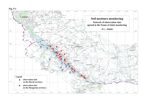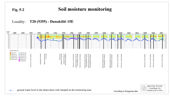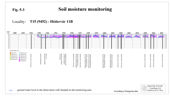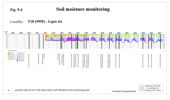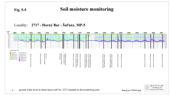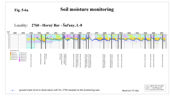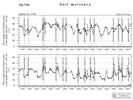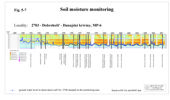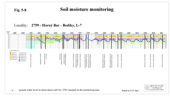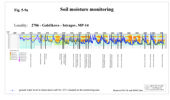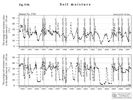PART 5
Soil Moisture Monitoring5.1. Data collection methodsThe soil moisture monitoring continued in the year 2007 according to the intergovernmental Agreement. Measurements on both sides were carried out without changes. No changes occurred in methodology during the whole period of observation. The Slovak side measured the soil moisture by a neutron probe down to a prescribed depth or to the depth of the ground water level. The Hungarian side measured the soil moisture with a capacity probe to the depth of 2 m. The soil moisture on both sides is expressed by the total soil moisture content in volume percentage recorded in 10 cm depth intervals for each measurement during the year. Measurements on the Slovak side were performed on 12 forest monitoring areas, on 5 biological monitoring areas and on 3 agricultural areas – Tab. 5-1. Measurements on the Hungarian side were performed on 6 forest monitoring areas and 5 agricultural areas - Tab. 5-2. Monitoring on three areas was abandoned. The situation of observation objects is shown on Fig. 5-1. Table 5-1: List of monitoring stations on the Slovak side
Table 5-2: List of monitoring stations on the Hungarian side
5.2. Data presentation methodsThe soil moisture is presented in figures showing the average soil moisture content in volume percentage for the depth interval from 0 to 100 cm and from 110 to 200 cm. A small difference can occur in the Hungarian data, where the value for a depth interval under 110 cm can represent the average value from less than 10 measured values. On colour figures the soil moisture time distribution for the whole measured depth is presented at selected sampling sites. The graphical presentation of the whole set of measured data is given in the Slovak and Hungarian National Annual Reports. 5.3. Evaluation of results on Hungarian sideIn 2007 the soil moisture measurements on the Hungarian side continued at forestry monitoring sites in the floodplain area and at agricultural monitoring sites in the flood-protected area (Fig. 5-1). The moisture conditions of soils are essentially influenced by the rainfall conditions, by the soil layer thickness and its composition, as well as by the ground water level position. The total amount of precipitation in 2007 was slightly higher than the long-term average, but the starting moisture content was low. Thanks to higher precipitation in March there was an increase of soil moisture recorded at every observation plots at the end of the month. The deeper parts of the soil profiles were supported from the groundwater level as well due to a lower discharge wave on the Danube. However, there were no precipitations during the next month, so the soil moisture content, especially in the uppermost layers, decreased. Deeper parts of the soil profile remained balanced. The precipitation amount in May varied locally and a discharge wave occurred again in the first half of the month. No significant changes in soil moisture content were recorded. Significant decrease was registered during the first half of June and the decrease on some monitoring areas continued until the end of August (T02, T04, T16, T17, T19). At the end of June heavy rainfalls were registered locally, which stopped the soil moisture decrease, even increase of soil moisture was recorded on some places (T06, T10, T15, T18, T20). Low precipitation amount, low water levels and high air temperatures during the summer months (from the end of June till the end of August) caused considerable decrease of soil moisture content in deeper layers as well. This decrease was stopped in September, when a flood wave occurred on the Danube. The soil moisture content increased and reached the level from the beginning of the year, at several places even higher. The development of soil moisture content till end of the year remained balanced. Generally it can be stated that the average soil moisture in 2007 was lower in comparison with the previous year. The soil moisture on forestry monitoring sites In general, the soil moisture content at all forestry monitoring areas was lower in comparison with the previous year. This is valid for minimal, maximal and average soil moisture contents in the layer to one-meter depth. Similar situation was in layers below one-meter depth, except the monitoring site T20. At the beginning of the vegetation period the soil moisture content reached significantly lower values than in the previous year. Minimal values in the layer to one-meter depth were recorded in August, while the minimal values in the layer below one-meter depth occurred in March. Maximal average soil moisture values in the layers down to 1-meter depth were recorded in various times due to different spatial and time distribution of rainfalls. The ground water level all over the year moisturised the soil layers on monitoring site T15 (Fig. 5-3), on monitoring sites T16 and T18 it moisturized the soil layers except the beginning of the year (Fig. 5-4). The soil on the monitoring site T20 was moisturized from ground water level from May to October (Fig. 5-2). Soil layers at monitoring site T17 and T19 were moisturized from the ground water level only in September. Table 5-3: The minimal and maximal average soil moisture contents at forestry monitoring sites
The soil moisture on agricultural monitoring sites on the flood protected side The soil moisture contents at monitoring sites T02, T04, T06 and T12 were mostly dependent on precipitation and weather condition. The ground water level influenced of the soil profile at monitoring site T10 and partially at monitoring sites T02, T04 and T12. The soil moisture content at monitoring site T06 in the year 2007 was influenced only by precipitation. The soil moisture values up to 1 m depth reached the maximum values at the beginning of the year and after the flood wave in September. Average soil moisture values at the end of the year were comparable to that from the beginning of the year. Minimal soil moisture values in the depth down to 1 m were registered at the end of August. In the soil layers below 1 m depth the maximal average values occurred in September, but on site T02 and T12 in June and on site T06 at the beginning of August. Minimal soil moisture values in the depth below 1 m depth were registered at the beginning of the year, in July and at the end of August. The minimal, average and maximal values were in mostly lower in comparison with the previous year. Monitoring sites T10 and T12 represent agricultural areas in the Middle and Lower Szigetköz. Both monitoring sites have a thick covering layer and throughout the vegetation period the ground water level moisturised the bottom part of soil layers. Table 5-4: The minimal and maximal average soil moisture contents at agricultural monitoring sites
5.4. Evaluation of results on Slovak sideMonitoring sites on the Slovak side are situated in the inundation area and flood-protected agricultural area (Fig. 5-1). Concerning the soil moisture development at monitoring sites situated in the agricultural area (sites No. 2716, 2717, 2718) it can be stated that the soil moisture content and the position and fluctuation of ground water levels during the whole observed period remained unchanged (Fig. 5-5). In the year 2007 the ground water level at monitoring site No. 2716 fluctuated in depths of 3-4 m, at site No. 2717 in depths of 2.5-3.5 m and at site No. 2718 in depths of 2-3 m. The fluctuation of soil moisture content in the depth interval from 0 to 1 m entirely depends on climatic conditions and irrigation. In the depth from 1 to 2 m, the soil moisture fluctuation is partly influenced by the ground water level, at monitoring area No. 2716 occasionally. The average soil moisture content in the depth down to 1 m in the year 2007 mostly fluctuated in the range from 5 to 20 % at monitoring site No. 2716, in the range from 9 to 22 % at monitoring site No. 2717 and in the range from 20 to 30 % at monitoring site No. 2718. Comparing these values with the previous year it can be stated that the soil moisture content in 2007 was slightly lower, especially in the layer up to 1 m depth. The soil moisture content was supplied during rainfalls in March, which was supported also by a small discharge wave on the Danube. Subsequently the soil moisture content started to decrease and at the end of August minimal values were recorded. Significant recharge came up during September and October 2007 and maximal values occurred at the end of the year (in November). In the depth between 1 and 2 m, the soil moisture content mainly varied from 15 to 20 % at monitoring site No. 2716, in the range from 31 to 37 % at monitoring site No. 2717 and in the range from 17 to 28 % at monitoring site No. 2718. Contrary to the upper layer the minimum values were recorded at the beginning of the year and the maximal values were registered in April. During the summer month significant decrease of soil moisture values were observed. Table 5-5: The minimal and maximal average soil moisture contents at agricultural monitoring sites
The soil moisture in the inundation area is, along with the ground water level and precipitation, highly dependent on natural or artificial floods. In hydrological year 2007 natural flood over 6000 m3s-1 occurred once. Small discharge waves around 3000-4000 m3s-1 had slight influence on the soil moisture, even on the monitoring areas below the confluence of the tailrace channel and the Danube old riverbed. The soil moisture content at the beginning of the year was very low and on some places the lowest values were recorded in the layer below one-meter depth (monitoring areas No. 2706, 2755, 2757, 2758, 2759 and 2760). Thanks to higher amount of precipitation increase of soil moisture content in the upper layer was recorded in March. Some increase was recorded in the layer between 1 and 2 m, but significantly lower and it was connected to a small discharge wave at the beginning of March. Higher increase occurred in May and June, when artificial flooding was simulated in the inundation area. In the middle part of the inundation area maximal values of average soil moisture content for this layer were recorded (monitoring areas No. 2705, 2759, 2760, 2761 and 2764). Climatic and hydrological conditions during summer months induced intensive drying and on most monitoring areas lowest values of soil moisture content were recorded at the end of August. Subsequently high amount of precipitation and a flood wave at the beginning of September replenished the soil moisture. Significant increase of soil moisture content was registered on every monitoring site. On some monitoring areas the highest average soil moisture values were recorded (monitoring areas No. 2704, 2706, 2707, 2756, 2757 and 3805) in both depth intervals. Higher amount of precipitation in October and November further increased the soil moisture content and in the layer up to one-meter depth maximal values were recorded on monitoring areas No. 2703, 2759, 2760, 2761, 2762, 2763 and 2764. The soil moisture content at the end of the year was significantly higher in comparison with the starting content at the beginning of the year. Concerning the minimal and the maximal values it can be generally stated that values were lower in comparison with the previous year at almost every monitoring site in both depth interval. The thickness of soil profile at monitoring sites No. 2703, 2764, 2763, 2762 and 2761 in the upper part of the inundation area is low, similarly to the Hungarian side. The ground water level at these places fluctuates in the gravel layer only. In 2007 the ground water level on area No. 2703 fluctuated from 1.5 to 5 m, on the areas No. 2764, 2763, 2762 and 2761 changed from 1.7-4.7 m. The average values of the soil moisture content in both depth intervals significantly fluctuated. Layers to 1 m depth were highly dependent on climatic conditions, however the flood in September had a great influence as well (Fig. 5-7). Layers below 1 m depth were strongly influenced by the ground water at the time of artificial flooding in May-June and during the flood in the Danube in September. Maximal average soil moisture contents occurred from September to November 2007. At monitoring sites 2761 and 2764 the maximal average soil moisture content in the layer below 1 m depth occurred during artificial flooding in May-June. Minimal values occurred in August. The thickness of the soil profile in the middle part of the inundation area is higher. In general the ground water regime in this region is influenced by the water supply of the river branch system, introduced in May 1993. Moreover, the natural or artificial floods have a high influence on the ground water level. The ground water level in 2007 fluctuated above the boundary between the soil profile and gravel layers - monitoring sites No. 2704, 2705, 2758, 2759, 2760 (Fig. 5-6a, Fig. 5-6b, Fig. 5-8) and supplied the soils with water for a greater part of the year. The maximal values of average soil moisture content in the layer to 1 m depth were reached in March and September 2007, minimal values occurred in August 2007. In the layer below 1 m depth the maximal values occurred in May-June, when artificial flooding was realised in the inundation area; the minimal values at the beginning of the year 2007. Table 5-6: The minimal and maximal average soil moisture contents at forestry monitoring sites
In the lower part of the inundation area, downstream of the confluence of the river branch system and the Danube (monitoring sites No. 2706, 2756, 2755), the ground water level usually fluctuates around the boundary between the soil profile and the gravel layer. Since the discharges in the Danube except the flood in September 2007 were low the groundwater level moisturised only the deeper part of the soil profile. Monitoring sites were flooded in September only. Due to riverbed erosion the ground water level fluctuated in the depth below 2 and 2.5 m. The soil moisture in the upper layer in 2007 was mostly dependent on precipitation. Significant refill occurred in March, but since then continuous decrease of soil moisture was characteristic during the whole vegetation period. The minimum and maximum values were related to the minimum and maximum ground water levels respectively. Minimal average values of soil moisture in layers up to 1 m depth occurred in July and August, in the layer below 1 m depth at the beginning of the year only. The maximal average values of soil moisture were reached after the flood in September 2007 (Fig. 5-9a, Fig. 5-9b). The soil moisture contents at monitoring sites No. 2707, 3804, 3805, located in the inundation below the confluence of the tailrace canal and the Danube old riverbed, are highly influenced by the flow rate regime in the Danube. The maximum values in 2007, in the depths down to 1 m and between 1 and 2 m, occurred in March and September, while the minimum values occurred at the beginning of the year and in August 2007. The ground water level at monitoring sites No. 2707, 3804 and 3805 fluctuated in the depth 0-4 m. The riverbed erosion negatively influences these monitoring areas. During low flow rates in the Danube the ground water level does not supply the soil profiles sufficiently.
|
|||||||||||||||||||||||||||||||||||||||||||||||||||||||||||||||||||||||||||||||||||||||||||||||||||||||||||||||||||||||||||||||||||||||||||||||||||||||||||||||||||||||||||||||||||||||||||||||||||||||||||||||||||||||||||||||||||||||||||||||||||||||||||||||||||||||||||||||||||||||||||||||||||||||||||||||||||||||||||||||||||||||||||||||||||||||||||||||||||||||||||||||
